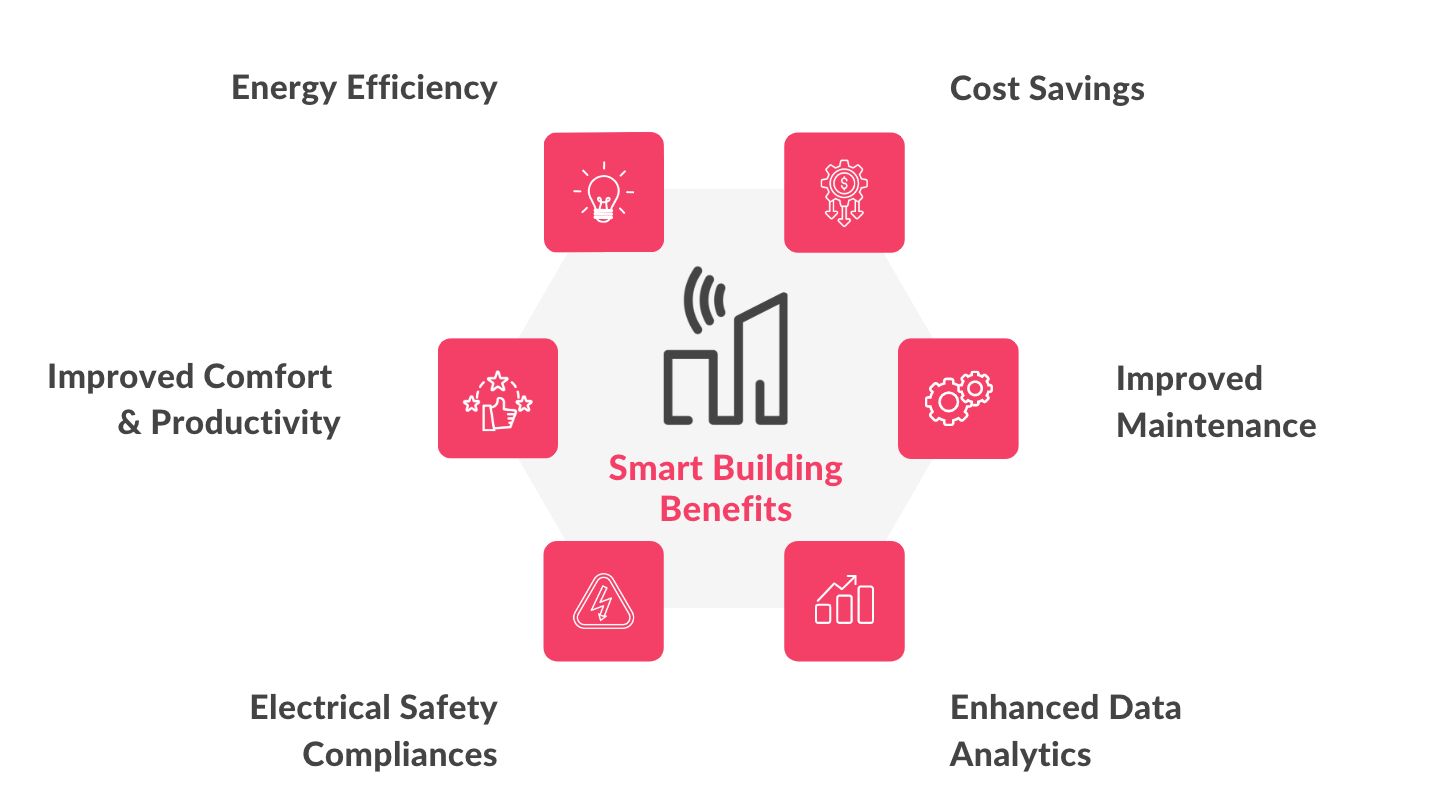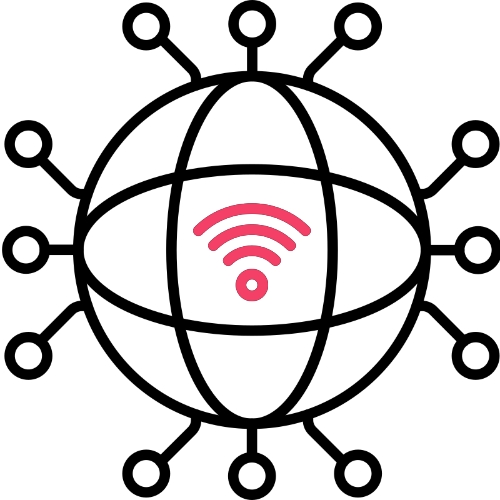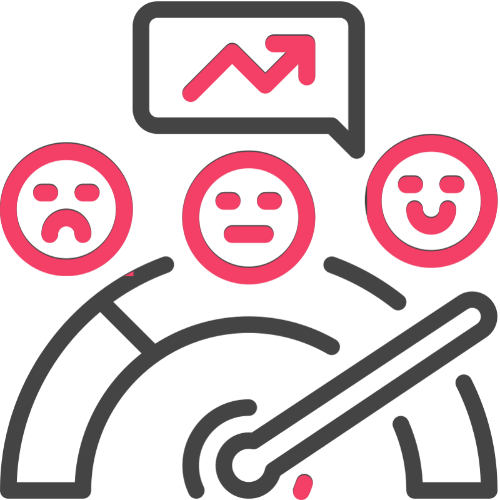As we move towards a more sustainable future, the demand for smart buildings is rising. These buildings leverage technology to optimize energy efficiency, enhance occupant comfort, and reduce operating costs. From lighting and HVAC systems to security and access control, these intelligent structures use a network of sensors and automation tools to provide an integrated, connected experience.
In this comprehensive guide, we’ll explore what smart buildings are, their benefits and different components, including their design, construction, and operation. We’ll also delve into their use cases, and examine the challenges of implementing this technology and ways to overcome them.
Whether you’re a building owner, facility manager, or just curious about the future of building technology, this guide will provide you with the knowledge you need to understand and appreciate the growing trend of smart buildings.
Table of Contents
ToggleDefinition of Smart Buildings
Smart buildings use advanced technologies to collect and analyze data from various systems and sensors throughout the building. This data is used to optimize the building’s operations and reduce energy consumption, resulting in significant cost savings for building owners & operators. For example, the HVAC system of a smart building can use sensors to detect certain areas that don’t require further cooling and adjust the temperature accordingly to save energy.
In addition to energy efficiency, smart buildings also offer enhanced occupant comfort. For instance, lighting systems can be automated to adjust brightness and color temperature based on the time of day or occupancy levels, creating a more comfortable and productive environment for occupants.
Smart buildings incorporate real-time equipment health and energy monitoring, which enables building owners and maintenance teams to gain valuable insights for proactive maintenance of the assets and equipment. This proactive approach leads to better returns on asset investments, lower maintenance costs and fewer equipment failures.
Overall, smart buildings leverage a range of interconnected systems and technologies to optimize their operations, reduce energy consumption, enhance occupant experiences, and improve the overall sustainability and efficiency of the building.
Benefits of Smart Buildings

1. Energy Efficiency
Smart buildings are designed to optimize energy consumption, thus reducing energy bills and minimizing carbon footprint. They achieve this through various methods, such as intelligent lighting, automated heating and cooling systems, and real-time energy monitoring.
2. Cost Savings
By optimizing energy consumption and automating processes, smart buildings can deliver cost savings for building owners. They can also help reduce maintenance costs by detecting problems before they become major issues, which helps prevent expensive repairs.
3. Improved Comfort and Productivity
Smart buildings use sensors to monitor air quality and adjust HVAC systems accordingly, which help reduce health risks and improve occupant comfort. Smart lighting systems can adapt to the natural light levels throughout the day, and HVAC systems can adjust temperature and airflow based on occupancy levels.
4. Electrical Safety Compliances
Smart buildings use energy meters that monitor various electrical safety parameters like voltage and current balance to detect potential safety hazards. Moreover, this also helps in reducing energy wastage.
5. Better Maintenance
Smart buildings can monitor the condition of their equipment in real time, enabling predictive maintenance and reducing downtime which helps minimize maintenance costs and improve the overall efficiency of building operations.
6. Enhanced Data Analytics
Smart buildings can generate vast amounts of data on their operations, which can be used to identify trends, optimize processes and make informed decisions.
Hence, smart buildings offer a wide range of benefits that can help building owners and operators save money, improve sustainability, and provide a more comfortable and productive work environment for occupants
Components of Smart Buildings
The components of smart buildings are the various systems that work together to automate and optimize building operations. Here’s a closer look at the main components of smart buildings:
A. Building Automation/Management Systems

Building automation systems (BAS) or Building management systems (BMS) are the backbone of smart buildings. These systems use a network of sensors, controllers, and actuators to automate and optimize building operations, including heating, ventilation, and air conditioning (HVAC), lighting, security systems, etc.
Advanced BAS/BMS, powered by IoT can be programmed to adjust systems based on occupancy, time of day, weather, and other factors. Some of the applications of BAS include:
1. HVAC Systems
BAS can automate and optimize HVAC systems to improve energy efficiency and occupant comfort. BAS can adjust heating and cooling based on occupancy, adjust airflow to improve indoor air quality, and provide real-time monitoring and alerts for equipment issues.
2. Lighting Systems
BAS can automate and optimize lighting systems to reduce energy consumption and improve occupant comfort. BAS can adjust lighting levels based on occupancy, time of day, and natural light.
3. Security Systems
BAS can also integrate security systems, such as access control systems, surveillance cameras, and alarms, to improve safety and security. BAS can provide real-time monitoring and alerts for security issues, integrate with emergency response systems, etc..
B. Internet of Things (IoT) Technologies
1. IoT Devices
Internet of Things (IoT) devices are small, connected devices that collect and transmit data to other devices and systems. IoT devices are a key component of smart buildings because they enable real-time monitoring and data analysis.
Some examples of IoT devices used in smart buildings include:
i) Sensors: Sensors can monitor temperature, humidity, light levels, air quality, and other environmental factors. This data can be used to optimize HVAC, lighting, and other systems, and to provide real-time alerts for equipment issues.
ii) Actuators: Actuators are devices that control equipment, such as motors, valves, and dampers. Actuators can be controlled by BAS and other systems to automate building operations and optimize energy consumption.
iii) Controllers: Controllers manage and coordinate IoT devices and systems. Controllers can provide real-time monitoring and data analysis and automate responses to equipment issues.
2. Connectivity
The connectivity aspect of IoT technology allows devices to either directly connect to the cloud (and hence have in-built IP communication such as Ethernet/WiFi/Cellular) or connect with an on-site gateway over wired (e.g., Modbus/BACnet) or wireless (e.g., Zigbee, OpenThread) protocols and the gateway then connects to the internet with its IP communication.
Such connection allows the data collected by the sensors to be transmitted to the cloud for further computation & analytics. Similarly, instructions sent by the users or algorithms are transmitted from the cloud to the actuators/relays.
3. Cloud Computing and Analytics
Cloud computing and analytics enable data analysis and storage in remote servers (i.e., “the cloud”). These are essential for smart buildings because they enable real-time monitoring and analysis of building data, allowing building operators to optimize building operations and improve occupant comfort.
Some examples of IoT-powered cloud computing and data analytics used in smart buildings include:
i) Data Collection: Cloud-based systems can collect data from IoT devices and other systems in real-time.
ii) Data Analytics: Cloud-based analytics can analyze data to identify patterns and trends, and to predict equipment failures and other issues.
iii) Predictive Maintenance: Cloud-based systems can use data analysis to predict when equipment is likely to fail, allowing building operators to schedule maintenance before a failure occurs, which helps reduce maintenance costs and minimize downtime.
4. User Interface/Dashboard
After the data processing stage, the processed data is presented on a dashboard. It provides centralized visibility & presents all the insights, which can be used to take and track corrective actions.
Smart Buildings Use Cases
Smart building technology is being adopted in various industries to improve energy efficiency, reduce costs, and enhance occupant comfort. Here are some examples of smart building use cases:
A. Hotels

1. HVAC Automation & Control
Smart building technology can help hotels optimize their HVAC systems.
2. Smart Lighting
Smart lighting systems use scheduling & occupancy sensors to adjust lighting based on occupancy and natural light level. This can help to reduce energy consumption, increase guest comfort, and save money on energy bills.
3. Energy Cost Savings
Smart building technology can help hotels monitor and manage their energy consumption. This can be achieved by using energy monitoring systems and analytics to identify areas of energy waste and implement energy-saving strategies.
4. Remote Asset Management
IoT-based smart building solutions allow building owners to monitor hotel assets & equipment remotely. This can be useful for large hotel chains, as it allows the maintenance team to identify and address issues from anywhere rather than physically visiting each site.
B. Retail Stores

1. Energy Management
Smart buildings can help retail stores optimize energy use and reduce costs by automatically adjusting lighting, heating, and cooling systems based on occupancy, weather conditions, and other factors. For example, lighting can be programmed to turn on and off based on store timings and customer traffic, and HVAC systems can be adjusted based on the temperature and humidity levels.
2. Enhanced Customer Comfort
Smart buildings can provide optimal indoor air quality by monitoring and controlling ventilation systems, air filtration, humidity & CO2 levels. This can improve the health and comfort of customers and employees and reduce the risk of airborne contaminants.
3. Refrigeration Monitoring System
In a QSR/Restaurant retail setup, a refrigeration monitoring system will continuously monitor and record the temperature and energy consumption data from the freezers, cold rooms, and other refrigeration equipment and provide insights on a dashboard. It will alert maintenance staff in case of any temperature deviations or anomaly detection.
C. Manufacturing Plants

1. Automated & Real-time Utilities Monitoring
Smart manufacturing setups powered by IoT use energy meters to monitor electricity incomers such as Grid, DG, Solar, and so on, and consumption by plant assets and equipment. Intelligent monitoring like this enables real-time visibility into crucial factors including energy usage, operating hours, power factor, and current and voltage health.
2. Machine Energy Benchmarking
The energy benchmarking method assesses the energy consumption of machinery and compares it to the performance of comparable machinery or a set norm. The most effective way for tracking the energy efficiency of machinery over time is energy benchmarking enabled by IoT.
It’s an important part of industrial energy management. Energy benchmarking simplifies the process of identifying inefficient machines, deciding on prospective changes, and making informed long-term energy management decisions.
3. Centralized Visibility
Smart building setups provide advanced data analytics and visualization. Such processed data is subsequently presented to stakeholders on their devices, such as computers or smartphones, as important actionable insights.
As a result, employing role-based access management, the complete system can be accessible from anywhere, providing for seamless centralized monitoring and control.
4. Fault Detection and Diagnosis
Smart building technology performs proactive asset and equipment maintenance, lowering the likelihood of failure.
Rather than a time-based or reactive strategy, it is based on metrics that monitor the actual state of assets. It analyzes voltage imbalance, power factor, and other factors to detect irregularities. In the event of an abnormality, an automatic ticketing system alerts the maintenance team for fast response.
D. Office Buildings

1. Energy Efficiency
Smart buildings reduce the energy consumption of office buildings by using advanced sensors, analytics, and machine learning algorithms. For instance, a building automation system can automatically adjust the temperature and lighting based on occupancy, time of day, and weather conditions. This can help save energy by reducing unnecessary heating or cooling when the building is not in use.
2. Indoor Air Quality
Smart buildings can improve indoor air quality by monitoring and controlling air ventilation, humidity, and temperature. For example, a smart building can automatically adjust the ventilation system based on occupancy levels & air quality sensors.
Smart Building Challenges
Smart building technology is becoming increasingly popular as it provides a range of benefits such as improved energy efficiency, enhanced security, increased comfort, and greater convenience for building occupants. However, like any emerging technology, there are challenges to be overcome before smart buildings can become the norm.
1. Interoperability

Smart building systems often rely on a variety of different devices and technologies. Ensuring that these devices can communicate with one another and work together seamlessly is critical. Standards like BACnet and OpenADR have been developed to address this challenge, but adoption is not yet widespread.
2. Data privacy and security

With so much data being collected by smart building systems, data privacy and security are critical concerns. Building owners and operators must ensure that their systems are secure and that sensitive data is protected. To address this challenge IoT-powered smart buildings use the same level of data security measures & encryption protocols as banking systems.
3. Cost

Implementing smart building technology can be expensive, especially for older buildings that may require significant upgrades to support the new technology. However, with the advent of IoT technology, retrofitting existing building infrastructure is easier than ever.
Read more about Retrofitting existing buildings with IoT for Sustainability & Energy Efficiency
4. User Adoption

Smart building technology is only as effective as its users. Building occupants must be willing to adopt and use the technology.
Smart Building Trends
1. Internet of Things (IoT) integration

IoT’s integration into smart building systems allows for better monitoring and control of building systems & equipment. IoT sensors and devices can provide real-time data on energy usage, indoor air quality, etc., allowing building operators to optimize building performance and improve the occupant experience.
2. Artificial Intelligence (AI)

AI is being used to improve smart building systems in various ways. For example, machine learning algorithms can be used to analyze data from sensors and other devices to identify patterns and anomalies that can be used to optimize building performance.
3. Energy Efficiency

Smart building technology is also increasingly used to improve energy efficiency. Building operators can use real-time data on energy usage to identify areas where energy can be saved and implement changes to reduce energy consumption. This can include everything from lighting and HVAC systems to building automation and energy management systems.
4. Indoor Air Quality (IAQ)

Smart buildings can monitor and manage IAQ in commercial buildings by using sensors to monitor air quality, ventilation systems to improve airflow, and air purification systems to remove contaminants.
5. Occupant Comfort

Smart building technology can be used to improve the comfort of building occupants, which includes automated lighting and temperature control to personalized settings that can be adjusted based on individual preferences.
6. Electrical Health and Safety

Building’s electrical systems are crucial components, and failures can have serious implications. To preserve electrical safety, IoT-based smart meters are used to monitor electrical systems and detect concerns such as voltage fluctuations, circuit breaker failures, and other difficulties.
Hence, smart building technology is rapidly evolving, with new trends and innovations emerging all the time. Building operators must stay up-to-date on these trends and adapt their strategies to take advantage of new technologies and best practices to optimize building performance and improve the occupant experience.
Summing up
In conclusion, smart buildings are the future across industries. By integrating various technologies such as IoT, AI, and automation, smart buildings can improve energy efficiency, optimize building performance, and enhance the occupant experience.
While the upfront costs of implementing smart building technology can be high, the long-term benefits in terms of energy savings, operational efficiency, and improved occupant comfort and safety far outweigh the challenges.
As the world becomes increasingly focused on sustainability and energy efficiency, smart buildings are poised to become the norm. By embracing smart building technology, building operators can not only reduce their environmental footprint but also enhance the value and desirability of their properties for occupants and other stakeholders alike.
In short, smart buildings represent a significant opportunity across industries to drive innovation and sustainability while improving the quality of life for building occupants.

